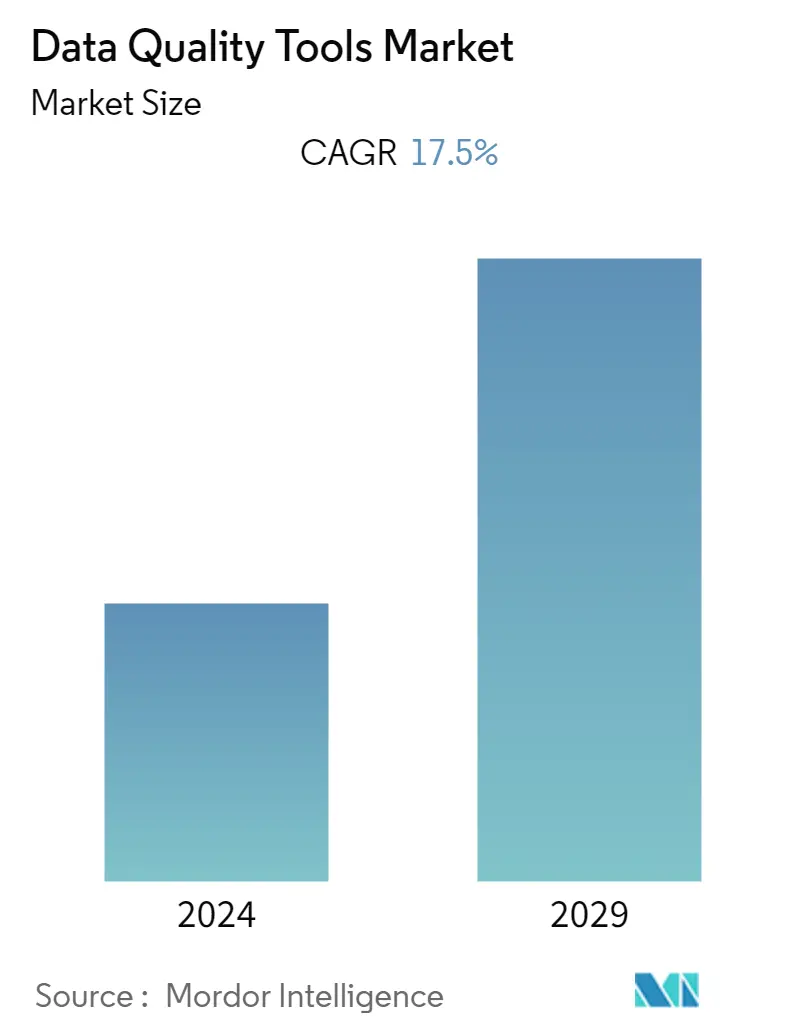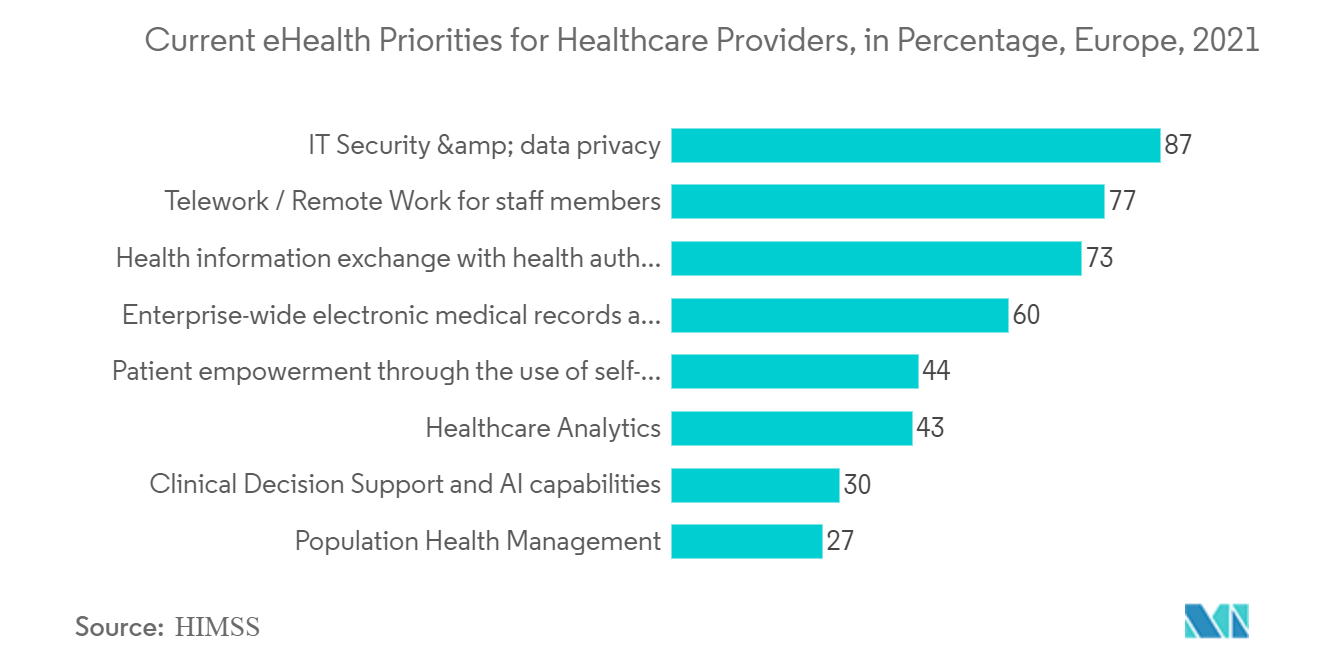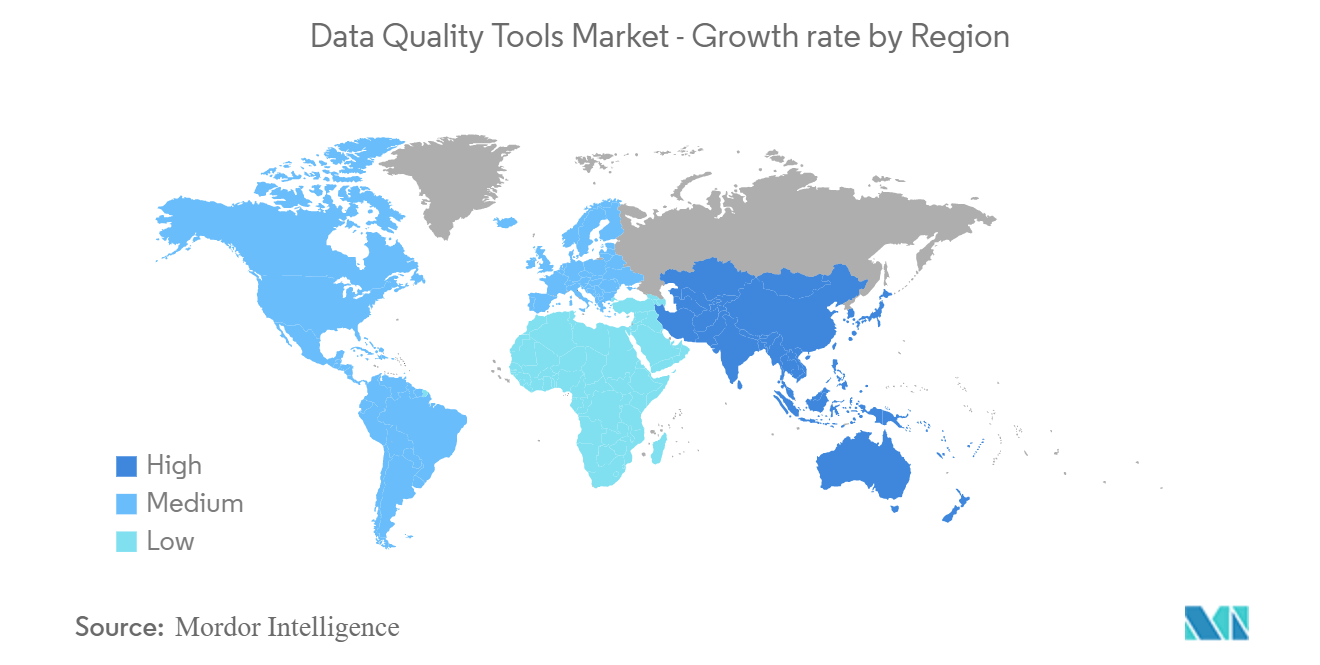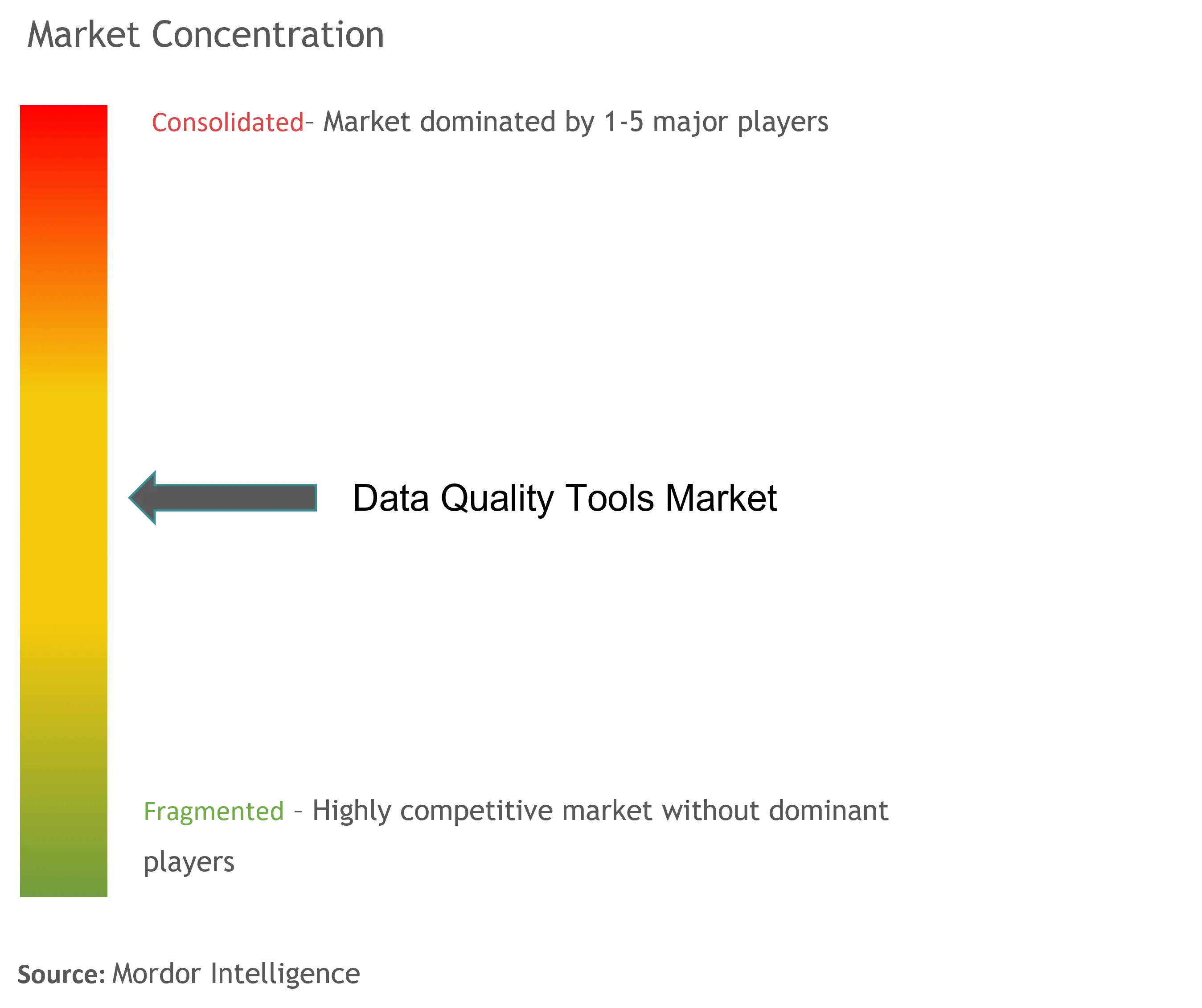Data Quality Tools Market Size

| Study Period | 2021 - 2029 |
| Base Year For Estimation | 2023 |
| CAGR | 17.50 % |
| Fastest Growing Market | Asia-Pacific |
| Largest Market | North America |
| Market Concentration | Medium |
Major Players
*Disclaimer: Major Players sorted in no particular order |
Data Quality Tools Market Analysis
The data quality tools market is expected to register a CAGR of 17.5% over the forecast period. Data quality tools generally address four primary areas: data cleansing, data integration, master data management, and metadata management. As data quality is a significant stake for large organizations, software companies are proposing increasing numbers of tools focusing on these issues. The focus of these tools is changing from specific applications (deduplication, address normalization, etc.) to a more global view that includes all aspects of data quality (profiling, rule detection, etc.).
- Furthermore, growing mobile connectivity and IoT adoption across all industries have resulted in a massive data explosion, necessitating data extraction from a variety of sources.The demand for data quality tool solutions is driven by these complex data types and formats.According to the Harvard Business Review (HBR), completing a unit of work with flawed data costs ten times more, and finding the right data quality tools has always been a challenge. One can implement a system of reliability by choosing and leveraging smart, workflow-driven, self-service data quality tools with embedded quality controls.
- Data quality tools generally address four primary areas: data cleansing, data integration, master data management, and metadata management. As data quality is a major concern for large organizations, software companies propose increasing the number of tools that address such issues. The scope of these tools is shifting from specific applications (deduplication, address normalization, etc.) to a more global perspective, integrating all areas of data quality (profiling, rule detection, etc.).
- Recent advances in mobile technology allowed users to automatically record data online, creating massive amounts of data that increased rapidly. Moreover, the capability and size of cloud computing infrastructures are continuing to accelerate, nearly beyond our abilities to leverage the opportunities provided.
- Moreover, the manufacturing sector handles multiple data streams that need to be analyzed to optimize business resources. These industries typically require handling routine, structured in-factory data, analog data, and information churned out from applications, including enterprise resource planning (ERP) systems and various process automation and control systems. Maintaining data quality would be significant for optimizing the manufacturing sector's supply chain. For instance, additive manufacturing (AM) needs tools to manage data to ensure quality, repeatability, traceability, and reliability, especially in the heavily regulated aviation and medical industries.
- Amid the COVID-19 outbreak, many companies were concerned about ensuring the quality and access to their data during this uncertain pandemic. The demand for various solutions that aid enterprises in data analytics has garnered significant attention and a positive trend in adoption. The global shift toward remote working and cloud adoption further intensified the demand for solutions that help increase work efficiency and effectiveness. Companies invested in processes and infrastructure to democratize data and enable access when the majority of the workforce works remotely as a result of the COVID-19 outbreak.
Data Quality Tools Market Trends
This section covers the major market trends shaping the Data Quality Tools Market according to our research experts:
Healthcare is Expected to Witness Significant Growth
- Data management in the healthcare sector is a complex process. It is composed of several key ingredients: data governance, data integration, data enrichment, data storage, and data analysis. While data processing systems are becoming critical components of operational decision-making and individualized treatment processes, poor data quality and management are becoming a primary interference with operational success and are causing significant strain on such methods.
- The healthcare industry's most commercial data collection tools are enterprise data warehouses (EDWs). They are designed to cluster data from multiple sources into a single, unified, and integrated data repository. The data is embedded within the EDW, so users can analyze the previously fixed data and get more ROI from existing source systems. Moreover, hospitals and care providers are adopting big data analytics and population health management technologies to meet the new healthcare standards' requirements and the growing demands and expectations of patients.
- Moreover, hospitals and care providers are adopting big data analytics and population health management technologies to meet the requirements of the new healthcare standards and the increasing demand and expectations of patients. BI tools can help improve quality performance by identifying system flaws and capturing missing data content.Healthcare business intelligence (BI) solutions, which analyze the data in electronic health records (EHRs), genetic studies, etc., can be applied for individualized treatment.
- The COVID-19 pandemic created a need for designing systems for the recording of care, as it would be used to create knowledge that the data generated from the system would be needed to plan services. The real-world importance of this information reinforced the real value that high-quality data can provide. It pulled together many data points, including survival data, comorbidities, and length of stay, which ultimately helped improve the patient experience and improve outcomes.
- Companies in healthcare are adopting new tools and collaborating to share data for an improved healthcare system. For instance, in August last year, Walmart announced that it joined the QCC, which supports data quality improvement in radiology services. The QCC is a national program to bring together payers, providers, and self-insured employers to improve radiology quality at scale.

Asia-Pacific Expected to Register the Highest Growth Rate
- In terms of revenue, the data quality tools market in Asia-Pacific is the one that is growing the fastest. This is primarily due to the increasing interest in data quality improvement solutions and a rising focus on data-driven scientific and strategic decision-making practices. With the growth of smart cities and the proliferation of IoT devices, the region is expected to witness unprecedented growth in the future. Also, the start-up culture, the government's ability to be flexible, and the growth of the eCommerce business are all important factors driving the market in the region.
- In October last year, China's State Council outlined a plan to create a "National Integrated Government Affairs Big Data System" that, by the year 2025, is expected to make millions of government data sets available from one place. The huge amount of data in one place would create the need for dynamic updates of databases and catalogs with continuous improvement of data quality.
- The firms are facing significant challenges with managing data for regulatory requirements and gaining meaningful insights. For example, the Reserve Bank of India (RBI) says that mobile banking transactions in India were worth more than INR 17,149,070 million (USD 2,102,47 million) in June of last year.
With such an abundance of data, there is a considerable risk of data quality issues in the banking and financial services industries. These data quality problems in the sector have a direct effect on the customer experience, interactions, transactions, and many other things. This means that the company has to pay more and loses money, which creates a need for data quality tools in the sector.

Data Quality Tools Industry Overview
The market for data quality tools could be more cohesive, with several domestic and international companies offering advanced solutions. Due to the presence of significant vendors in the market, the intense competition encourages them to focus on areas to enhance their customer reach across various geographies. Additionally, different data quality tool providers are focusing more on providing a comprehensive set of solutions to their customers to gain increased market traction.
In October 2022, Anomalo, the complete data quality platform company, announced a partnership with dbt Labs to provide data quality for dbt metrics, a part of the new dbt Semantic Layer. dbt is a transformation framework that enables businesses to transform, test, and document data in the cloud, producing data that the entire organization can use.
In January 2022, IBM Corporation and Francisco Partners, a global investment firm specializing in partnering with technology businesses, announced the signing of a definitive agreement under which Francisco Partners is expected to acquire healthcare data and analytics assets from IBM, which are presently part of the Watson Health business. Francisco Partners bought a lot of different kinds of data and products, such as MarketScan, Health Insights, Clinical Development, Micromedex, Social Program Management, and imaging software.
Data Quality Tools Market Leaders
-
IBM Corporation
-
Oracle Corporation
-
SAP SE
-
Informatica LLC
-
Talend Inc.
*Disclaimer: Major Players sorted in no particular order

Data Quality Tools Market News
- September 2022: MIT Computer Science and Artificial Intelligence Laboratory (CSAIL) spin-off DataCebo announced the launch of a new tool, dubbed Synthetic Data (SD) Metrics, to help enterprises compare the quality of machine-generated synthetic data by pitching it against real data sets.
- May 2022: Pyramid Analytics, which developed its flagship platform, Pyramids Decision Intelligence, announced that it raised USD 120 million in a Series E round of funding. The Pyramid Decision Intelligence platform combines business analytics, data preparation, and data science capabilities with AI guidance functionality. It enables governed self-service analytics in a no-code environment.
Data Quality Tools Market Report - Table of Contents
1. INTRODUCTION
- 1.1 Study Assumptions and Market Definition
- 1.2 Scope of the Study
2. RESEARCH METHODOLOGY
3. EXECUTIVE SUMMARY
4. MARKET INSIGHT
- 4.1 Market Overview
- 4.2 Industry Value Chain Analysis
-
4.3 Industry Attractiveness - Porter's Five Forces Analysis
- 4.3.1 Bargaining Power of Suppliers
- 4.3.2 Bargaining Power of Consumers
- 4.3.3 Threat of New Entrants
- 4.3.4 Threat of Substitute Products
- 4.3.5 Intensity of Competitive Rivalry
- 4.4 Assessment of COVID -19 impact on the market
5. MARKET DYNAMICS
-
5.1 Market Drivers
- 5.1.1 Increasing Use of External Data Sources Owing to Mobile Connectivity Growth
-
5.2 Market Restraints
- 5.2.1 Lack of information and Awareness about the Solutions Among Potential Users
6. MARKET SEGMENTATION
-
6.1 By Deployment Type
- 6.1.1 Cloud-based
- 6.1.2 On Premise
-
6.2 By Size of the Organization
- 6.2.1 Small and Medium Enterprises
- 6.2.2 Large Enterprises
-
6.3 By Component
- 6.3.1 Software
- 6.3.2 Services
-
6.4 By End-user Vertical
- 6.4.1 BFSI
- 6.4.2 Government
- 6.4.3 IT & Telecom
- 6.4.4 Retail and E-commerce
- 6.4.5 Healthcare
- 6.4.6 Other End-user Industries
-
6.5 Geography
- 6.5.1 North America
- 6.5.2 Europe
- 6.5.3 Asia-Pacific
- 6.5.4 Latin America
- 6.5.5 Middle East and Africa
7. COMPETITIVE LANDSCAPE
-
7.1 Company Profiles*
- 7.1.1 IBM Corporation
- 7.1.2 Informatica LLC
- 7.1.3 Oracle Corporation
- 7.1.4 SAP SE
- 7.1.5 SAS Institute Inc.
- 7.1.6 Talend Inc.
- 7.1.7 Experian PLC
- 7.1.8 Information Builders Inc.
- 7.1.9 Pitney Bowes Inc.
- 7.1.10 Syncsort Inc.
- 7.1.11 Ataccama Corporation
8. INVESTMENT ANALYSIS
9. FUTURE OF THE MARKET
** Subject To AvailablityData Quality Tools Industry Segmentation
Data quality tools are programs or applications that are used to analyze datasets and convert them into meaningful information by identifying problems and resolving them. They are used to improve the quality of datasets such as customer data, financial data, supplier data, product data, etc. These tools are used by organizations to ensure the quality of data being delivered to different business processes such as decision making, business intelligence (BI), and analytics. These tools help with different parts of data quality problems, such as enriching, monitoring, cleaning, matching, parsing, and profiling data.
The market sizes and forecasts are provided in terms of value (USD million) for all the above segments.
| By Deployment Type | Cloud-based |
| On Premise | |
| By Size of the Organization | Small and Medium Enterprises |
| Large Enterprises | |
| By Component | Software |
| Services | |
| By End-user Vertical | BFSI |
| Government | |
| IT & Telecom | |
| Retail and E-commerce | |
| Healthcare | |
| Other End-user Industries | |
| Geography | North America |
| Europe | |
| Asia-Pacific | |
| Latin America | |
| Middle East and Africa |
Data Quality Tools Market Research FAQs
What is the current Data Quality Tools Market size?
The Data Quality Tools Market is projected to register a CAGR of 17.5% during the forecast period (2024-2029)
Who are the key players in Data Quality Tools Market?
IBM Corporation, Oracle Corporation, SAP SE, Informatica LLC and Talend Inc. are the major companies operating in the Data Quality Tools Market.
Which is the fastest growing region in Data Quality Tools Market?
Asia-Pacific is estimated to grow at the highest CAGR over the forecast period (2024-2029).
Which region has the biggest share in Data Quality Tools Market?
In 2024, the North America accounts for the largest market share in Data Quality Tools Market.
What years does this Data Quality Tools Market cover?
The report covers the Data Quality Tools Market historical market size for years: 2021, 2022 and 2023. The report also forecasts the Data Quality Tools Market size for years: 2024, 2025, 2026, 2027, 2028 and 2029.
Data Quality Tools Industry Report
Statistics for the 2024 Data Quality Tools market share, size and revenue growth rate, created by Mordor Intelligence™ Industry Reports. Data Quality Tools analysis includes a market forecast outlook to 2029 and historical overview. Get a sample of this industry analysis as a free report PDF download.



